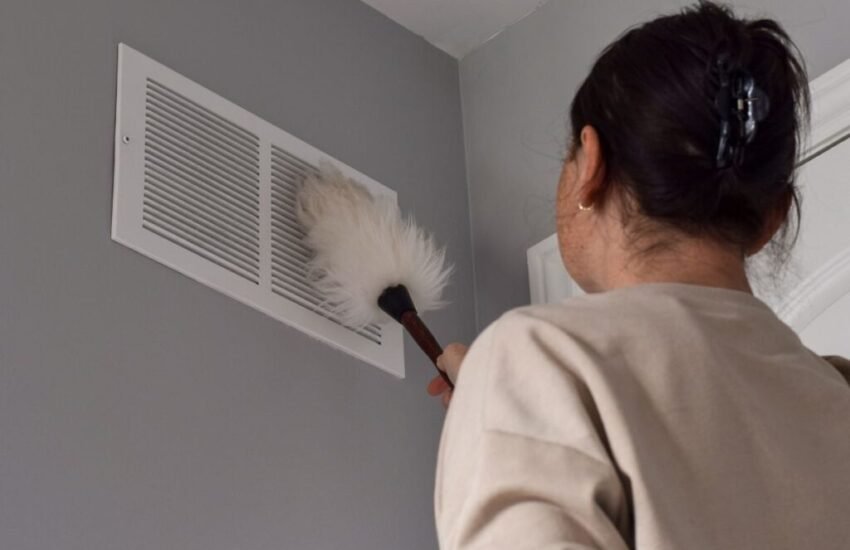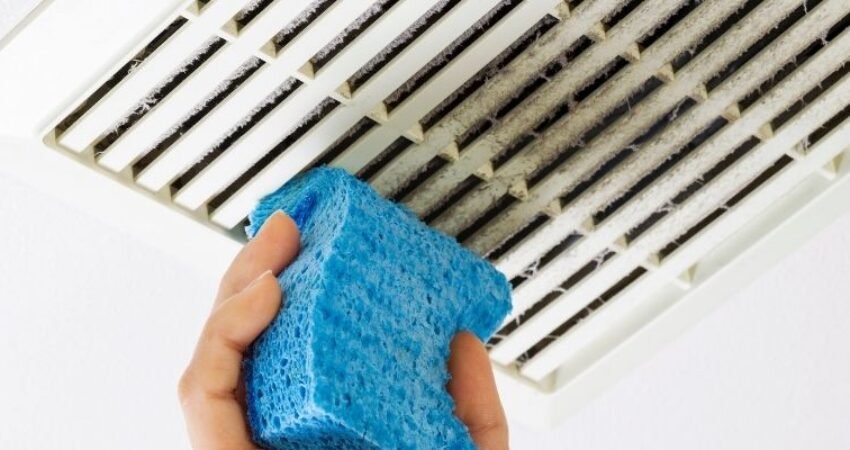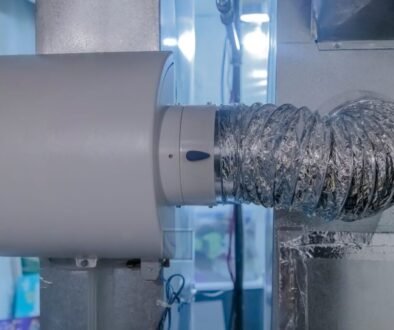The Ultimate Guide to Getting Rid of Mold in Air Ducts

Published October 19, 2023
Dealing with mold growth is crucial when it comes to maintaining a healthy and comfortable living environment. Mold in air ducts can pose serious health risks and affect your HVAC system’s efficiency. If left untreated, mold can spread throughout your home, leading to respiratory issues, allergies, and other health concerns.
Thus, in this article, we will explore all things mold-related and, most importantly, how to remove it.
Types of Molds in Air Vents
Various types of mold can be found in air ducts. Each mold has its characteristics and may pose different health risks if left untreated.
Acremonium
Acremonium is a mold that typically appears as a white powdery substance. It grows slowly but can release dangerous toxins into the air, posing health risks.
Alternaria
Alternaria is a prevalent type of mold found in air ducts. It can appear as dark green or black spots. They cause allergies and respiratory issues, particularly in individuals with weakened immune systems.
Aspergillus
Aspergillus molds come in various colors, including green, yellow, and brown. They can thrive in moist environments. They produce harmful mycotoxins that can trigger allergies, asthma, and other respiratory conditions.
Chaetomium
Chaetomium molds are often found in water-damaged areas. They have a cotton-like texture and typically appear as white or gray patches. Exposure to Chaetomium may cause allergic reactions and respiratory problems.
Fusarium
Fusarium molds can grow in humid conditions and tend to be pink or white. They can produce mycotoxins and may lead to eye, skin, and respiratory infections.
Mucor
Mucor is a type of mold that thrives in damp environments. It usually has a whitish or grayish appearance and can cause allergies and respiratory issues.
Trichoderma
Trichoderma molds can appear in various colors, including green, blue, or white. They can grow in damp environments. They cause allergic reactions, particularly in individuals with sensitivities.
Black Mold in Air Conditioner
Another type of mold found in AC units is the Stachybotrys, also known as black mold. It is commonly found in areas with high moisture levels. It produces mycotoxins that can pose severe health risks, including respiratory problems.
This dark green or black mold can thrive in moist environments, such as inside an air conditioning unit. Too much humidity or a water leak in your AC can create perfect mold conditions.
Not only does black mold look unpleasant, but it can also cause health issues if it spreads and releases spores into the air you breathe. Addressing black mold by seeking professional help to clean and remove it from your air conditioner is essential.
Black Mold in AC: Symptoms
When black mold grows in an air vent, it can cause several symptoms. Here are some common symptoms:
Musty Odor
You might notice a strong, unpleasant smell coming from your AC. It can be described as a damp or musty odor, like the smell of wet socks or a dirty basement. This smell is caused by the mold releasing volatile organic compounds (VOCs).
Allergic Reactions
Black mold can trigger allergic reactions in some people. It could be a sign of mold presence if you have symptoms like sneezing, coughing, itchy eyes, nasal congestion, or a runny nose whenever you’re near the AC.
Respiratory Issues
Inhaling mold spores can irritate your respiratory system. It can lead to difficulty breathing, wheezing, chest tightness, or persistent coughing. People with pre-existing respiratory conditions like asthma may experience worsening symptoms.
Skin Irritation
Direct contact with black mold can cause skin irritation or rashes. If you notice redness, itchiness, or a rash developing in areas that come into contact with the moldy AC, it’s best to avoid touching it.
Eye Irritation
Mold spores in the air can also irritate your eyes. You may experience redness, itching, watering, or a gritty sensation in your eyes.
It’s important to note that these symptoms can vary. It depends on the individual’s sensitivity to mold and the severity of the infestation.
Suspect black mold in your AC unit? Are you experiencing any of these symptoms? It’s advisable to consult a professional for proper assessment and remediation.
How Does Mold Grow?
Mold requires three essential elements to grow: moisture, a food source, and suitable temperatures. Air ducts can provide an ideal environment for mold growth as they often accumulate moisture from condensation or leaks. Dust and debris in the ducts serve as a food source for mold spores.
When these conditions are met, the mold spores can multiply rapidly, leading to a full-blown infestation.
Related: Water Dripping from AC Vents: Causes and Solutions
The Signs of Mold Growth in Air Ducts
Detecting mold growth in air ducts can be challenging as they are hidden from view. But there are some telltale signs that you can look out for:
Musty odor
A strong, musty smell from your vents or when the HVAC system runs may indicate mold growth.
Visible mold
If you spot any visible mold growth around the vents or on the surface of the ducts, it is a clear sign of a problem.
Allergic reactions
If you or your family members experience unexplained allergies or respiratory issues, mold in the air ducts could be the culprit.
How to Remove Mold from Air Ducts
Removing mold from air ducts is a meticulous process that requires careful planning and execution. It is recommended to hire a professional mold remediation service for this task. But if you prefer a DIY approach, here are some steps you can take:
Step 1: Safety precautions
I advise you to wear proper protective gear, including gloves, goggles, and a mask, to avoid exposure to mold spores.
Step 2: Identify the source
Determine the cause of mold growth, such as leaks or excess moisture, and address it before removal.
Step 3: Clean the ducts
Thoroughly clean the affected areas using a HEPA vacuum cleaner to remove loose mold spores and debris.
Step 4: Disinfect
I recommend using an antimicrobial solution to kill any remaining mold spores and prevent regrowth.
Step 5: Seal the ducts
Apply an HVAC-approved sealant to prevent mold spores from spreading further.

Preventive Measures to Take
Once you have successfully removed mold from your air ducts, it is crucial to take preventive measures to ensure it does not return. Here are some steps you can follow:
Maintain proper ventilation
Ensure that your home has adequate airflow to reduce moisture buildup.
Control humidity levels
Use dehumidifiers or air conditioners to keep humidity levels below 50%.
Regular inspections
Conduct routine checks of your air ducts for any signs of moisture or mold growth.
Cleanliness
Keep your home clean and free of dust and debris, as they can serve as food sources for mold.
Professional maintenance
Schedule regular HVAC maintenance to address any potential issues and ensure optimal performance.
Conclusion
Mold growth in air ducts is a problem that should be addressed to maintain a healthy indoor environment. Whether hiring professionals or doing it yourself, always focus on safety and follow the recommended guidelines. You can breathe easily with proper maintenance and preventive measures, knowing your air ducts are mold-free.

This Content Is Fact Checked
This content has undergone thorough fact-checking by our team of internal experts. Gain further insight into the editorial standards upheld on our website here.
South Florida HVAC Professionals
Snowflakes Air Conditioning has been providing professional HVAC services for over 10 years. We are committed to keeping your air conditioner running smoothly all year round. Our experienced technicians can handle anything from AC repair to sales and AC installation. Whether it’s time for an upgrade or just regular upkeep, we are a name you can trust for your HVAC needs. Contact us today for more information.

About The Author
Meet writer Rei Bayucca, an HVAC and construction industry enthusiast. Discover insightful articles designed to help you solve your most pressing problems. Rei can captivate you with expertly crafted content that will leave you hungry for more.



